Our OTK Demon Hunter deck list guide goes through the ins-and-outs of this combo Demon Hunter deck that has become the favorite deck of many high-level players! This guide will teach you how to mulligan, pilot, and substitute cards for this archetype!
Introduction to OTK Demon Hunter
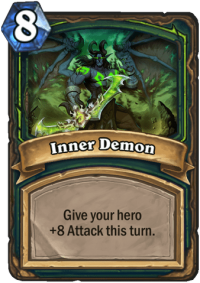
OTK Demon Hunter is based on a simple idea: Kael'thas Sunstrider makes some of your spells free and Demon Hunter has a huge damage spell in Inner Demon as well as several cheap spells, primarily Twin Slice, to activate Kael’s effect. Therefore, going for a big combo turn where you cast lots of spells and buff the attack of your Hero to 20 or more sounds like a great idea. It also really works!
OTK Demon Hunter is a bit of a misnomer though. The deck is more accurately a Combo Demon Hunter because it very rarely deals 30 damage in a single turn for a true one-turn-kill. The deck is capable of doing that under specific circumstances, and it is a viable strategy against slow decks such as Priest, but against most decks, the damage is dealt throughout the game with a smaller burst at the end, and sometimes the combo pieces are even used for survival or more card draw.
All of this makes OTK Demon Hunter one of the most complicated decks in the game at the moment, and unless you enjoy playing lots of games to master a complex deck so that you can start winning games, you are probably better off with Tempo Demon Hunter. That said, if you welcome the challenge, you are at the right place to get started on your journey.
OTK Demon Hunter Deck List
Check out alternative versions of this deck on our OTK Demon Hunter archetype page!
OTK Demon Hunter Mulligan Strategy & Guide
VS Fast Decks
Higher Priority (Keep every time)
- Eye Beam – Defensive removal spell.
- Crimson Sigil Runner – Great early card draw minion.
- Twin Slice – While it can be part of your combo, you need early removal against aggro.
- Chaos Strike – Early removal that also draws a card.
Lower Priority (Keep only if certain conditions are met)
- Skull of Gul'dan – You want to draw cards and really want to draw them with a discount. With expensive cards in the deck, keeping the Skull is the best chance you have to activate its Outcast effect. Only Hunter is too fast of an opponent to keep the Skull.
- Immolation Aura – Great early-game area-of-effect damage card that just happens to destroy most of the minions used by Tempo Demon Hunters. Keep against Demon Hunter and Shaman.
VS Slow Decks
Higher Priority (Keep every time)
- Skull of Gul'dan – You want to draw cards and really want to draw them with a discount. With expensive cards in the deck, keeping the Skull is the best chance you have to activate its Outcast effect.
- Crimson Sigil Runner – Card draw is what you want to go for in slow matchups.
- Spectral Sight – Card draw is what you want to go for in slow matchups.
- Novice Engineer – Card draw is what you want to go for in slow matchups.
OTK Demon Hunter Play Strategy
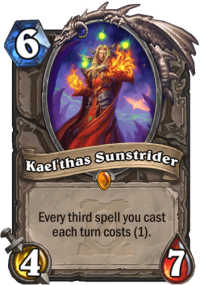
Ideally, you want to end games with a big Kael'thas Sunstrider combo. Because Kael’thas makes every third spell free, you can play Twin Slice + Second Slice + Inner Demon + Twin Slice + Second Slice + Inner Demon for 20 damage for zero mana. This means that you can unleash your combo as early as turn five with Kael’thas on Coin (remember to change the order of spells if you use a Coin), and that is what makes OTK Demon Hunter so dangerous.
There are lots of variations of the theme. Often, you want to set up Metamorphosis before your combo turn to weave in a five-damage Hero Power. Sometimes you add Kayn Sunfury to the mix so that you can hit regardless of any Taunt minions. Sometimes you hold on to the Coin to use the Metamorphosis Hero Power with Kael’thas and Kayn for a total of 11 mana. Sometimes you manage to discount Kael’thas or Kayn with Skull of Gul'dan and can add in lots of damage in a single turn. Sometimes you add Altruis the Outcast to the mix for more damage and minion removal.
Most of the time you cannot deal 30 damage directly from hand, so you will use one charge of Metamorphosis on the turn before or after your combo, sometimes in combination with Zephrys the Great for a Fireball or another damage source.
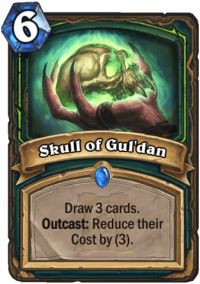
Skull of Gul'dan is your most important Outcast card. You want to get the discounts for a huge combo turn or for setting up a big Altruis the Outcast turn where you play cheap or free cards one after another to repeatedly activate Altruis. However, unlike with Tempo Demon Hunter, OTK Demon Hunter cannot always play the Skull from an Outcast position. Having your Skull imprisoned between Inner Demon and Kael'thas Sunstrider happens, and you need to decide the best way to deal with that on a case-by-case basis: sometimes you let go of the full combo to get a good Skull, and sometimes you play the Skull without discounts to preserve the full combo. Sometimes you even play Kael’thas and cheap spells to then play an Outcast Skull of Gul'dan. Yes, this means giving up on your combo, but all the damage is still there, you will just not be able to fit it all in a single turn unless Kael’thas survives on the board.
Similar considerations apply to all of your Outcast cards: they can and will get trapped sometimes, and you need to decide whether to play them without the Outcast effect or whether to use some of the cards that are preventing them from reaching the edge for that sweet bonus. This is why many of the Outcast cards are good keeps in the mulligan: when you start the game with them, it is less likely that they are unable to reach the edge of your hand. Occasionally you will still draw that early Inner Demon if you mulligan your left-most card away, but you can work your way even through that.
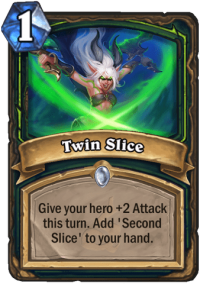
After the nerfs, there is a peculiar interaction between Skull of Gul'dan and Eye Beam: an Eye Beam discounted to zero by the Skull will actually cost one mana if it is in the Outcast position. This interaction is intentional and something you need to take into account when planning your turns.
Twin Slice is one of the most valuable cards in the deck, do not waste it unnecessarily! It is a key part of the full combo and has synergy with Altruis. However, sometimes you have to spend it for early removal against aggressive decks. Note that Twin Slice is not a Twinspell: the Second Slice that you get will be the right-most card in your hand, ready for use with Altruis.
Zephrys the Great plays an interesting role in the deck. It can provide you with board clears or additional damage, but often you end up playing it from hand before its effect is active, just to get it out of the way for some Outcast action. The slower the matchup, the more likely you are to use Zephrys for value, and the faster the matchup, the more likely you are to use it as a 3/2 minion, sometimes as early as on turn two.
VS Aggro Decks
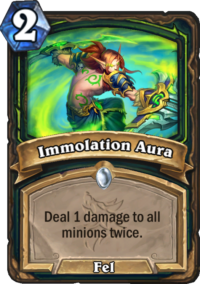
Against aggressive decks, you need to stay alive. Early removal tools such as Immolation Aura, Eye Beam, Twin Slice, and Chaos Strike are essential to fend off the aggro deck’s assault.
Once you reach the mid-game, you can use Kael'thas Sunstrider with Skull of Gul'dan to draw and Aldrachi Warblades with damage buffs, including Inner Demon, to heal for massive amounts. Sometimes you end up racing the aggro deck with a Kael’thas combo, if you happen to draw the right pieces early enough.
Whenever you use Aldrachi Warblades, try to maximize the healing you get. Damage buffs are good with the weapon, and you may often want to hold back a charge so that you can swing with some big buffs.
Because your combo is not an actual OTK that you put together and then win the game, there is a lot of flexibility in your game plan. You can use individual pieces of the combo early or even for completely different purposes, and against aggro decks you often have to.
VS Control Decks
Against control decks, your plan is much more simple than against aggro. Put together a big damage combo. Win the game.
Now, the real problem is how you get there. You typically do not need to worry too much about survival, but you need to worry about activating your Outcast effects while still holding on to your combo potential. If you chip in damage over a long period of time, control decks will simply heal back up. It is still good to deal damage when you can because the control player will feel uncomfortable whenever they are at around 20 Health and within the reach of your most common combos. This can create just the right tension and reveal whether they have healing available.
OTK Demon Hunter Card Substitutions
Combo decks are difficult for card substitutions because you cannot break the main combo. OTK Demon Hunter luckily has a number of expensive cards that you can also live without.
- Bloodmage Thalnos can be replaced with a Loot Hoarder. The Spell Damage is of minor value is this archetype, and while it occasionally gives you a board clear, it is more often just another card draw tool.
- Zephrys the Great can be replaced with another Loot Hoarder for more draw or with Blade Dance for more defensive tools.
- Kayn Sunfury can be replaced with Blade Dance for more defensive tools.
- Metamorphosis is the most difficult expensive card to replace because it gives you the reach you need to end the game. There are currently no widely played lists that do not include it.

how it is possible that you draw Eye Beam using Skull of Guldan and it costs 1 mana. Logic?
someone mentioned it before???
The Outcast effect of Eye Beam is that it costs (1). That overrides the discount from Skull of Gul’dan when Eye Beam is your left-most or right-most card.
when it is at the outcast position. It is 1 mana, right?
skull of guldan says the cards you draw cost 3 less, right?
then 1-3=below zero right? it should be zero cost anyway, right?
so?
With Altruist at 4 and Kaelthas at 7 i don’t know if the deck will survive
I honestly think that it should still be okay